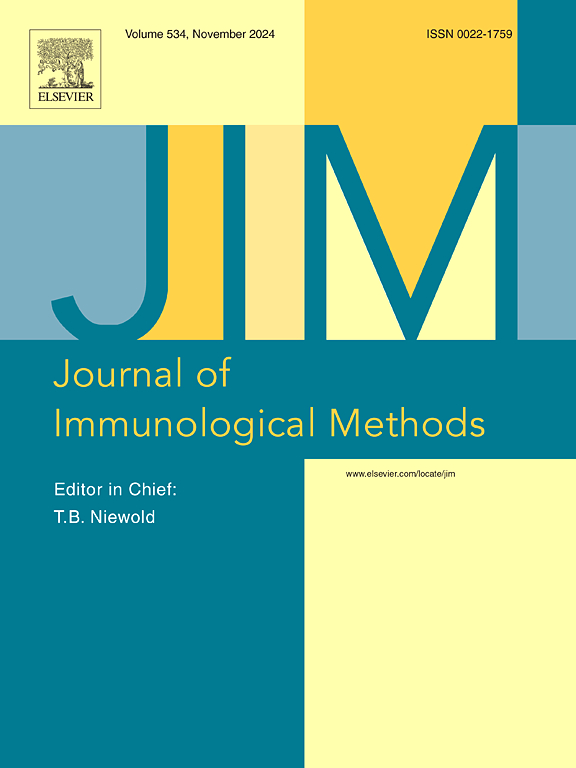m痘和水痘一步诊断鉴别免疫层析方法的建立
IF 1.6
4区 医学
Q4 BIOCHEMICAL RESEARCH METHODS
引用次数: 0
摘要
目的天花和水痘是一种具有相似临床症状和共感染的高度传染性疾病,诊断检测对其鉴别具有重要意义。m痘病毒和水痘病毒分别是m痘和水痘的主要致病菌。本研究旨在建立一种快速诊断的免疫层析方法,用于m痘和水痘病毒的鉴别诊断。方法建立基于双抗体夹心格式的免疫层析(ICA)方法。首先制备配对单克隆抗体(MAbs):针对m痘,检测MAb1并捕获MAb2;对于水痘,检测MAb3并捕获MAb4。这些单克隆抗体针对m痘和水痘病毒的重组抗原(AR/gE)。然后,将检测单克隆抗体与金纳米粒子偶联并涂覆在偶联片上。将捕获的单克隆抗体固定在两个检测区域的硝化纤维素膜上,分别形成Test 1 (T1,检测AR)和Test 2 (T2,检测gE)系。将山羊抗小鼠IgG抗体固定在硝化纤维素膜上,形成对照(C,验证条带的有效性)线作为对照。最后将其组装成一步双t线胶体金免疫层析试纸条,用于mpox和水痘病毒的鉴别诊断。用m痘假病毒和临床标本进行敏感性、特异性、精密度和方法学比较。结果制备了同时检测mpox和水痘的双指标ICA试纸条。双指数ICA试纸对AR抗原的敏感性为0.125 ng/mL,对gE抗原的敏感性为0.25 ng/mL,具有较高的特异性、精密度和重复性。在10-15 min内可判断结果。56份临床样本的方法学比较研究(PCR与ICA条)发现ICA条与PCR法无统计学差异。结论双指标ICA试纸具有良好的灵敏度、特异度、操作简便、检测速度快等优点。该方案非常适合医疗机构和个人对mpox和水痘的早期诊断和鉴别。本文章由计算机程序翻译,如有差异,请以英文原文为准。
Development of a one-step diagnostic and differential immunochromatographic method for mpox and chickenpox
Objective
Mpox and chickenpox are highly contagious diseases with similar clinical symptoms and co-infection, and diagnostic tests are extremely useful in their differentiation. Mpox virus and chickenpox virus are the main causative pathogens of mpox and chickenpox respectively. This study aims to develop a rapid diagnostic immunochromatographic trip for differential diagnosis of mpox and chickenpox viruses.
Methods
An immunochromatographic assay (ICA) based on the double-antibody sandwich format was developed. First, the paired monoclonal antibodies (MAbs) were prepared: for mpox, the detecting MAb1 and capture MAb2; for chickenpox, the detecting MAb3 and capture MAb4. These MAbs were against the recombinant antigens (AR/gE) of mpox and chickenpox viruses. Then, the detecting MAbs were conjugated to gold nanoparticles and coated onto the conjugate pads. The capture MAbs were immobilized onto a nitrocellulose membrane at two detection zones to form the Test 1 (T1, to test AR) line and Test 2 (T2, to test gE) line, respectively. Goat anti-mouse IgG antibodies were immobilized onto the nitrocellulose membrane to form the control (C, to verify the effectiveness of the strip) line as the control. Finally, it was assembled into a one-step double T-line colloidal gold immunochromatographic test strip for the differential diagnosis of mpox and chickenpox viruses. The sensitivity, specificity, precision and methodology comparison were evaluated using mpox pseudovirus and clinical samples.
Results
A dual-index ICA strips for the simultaneous detection of mpox and chickenpox were successfully prepared. The sensitivity of the dual-index ICA strips to AR antigen was 0.125 ng/mL, to gE antigen was 0.25 ng/mL, with high specificity, precision and reproducibility. The results can be judged within 10–15 min. Methodology comparison study (PCR vs. ICA strips) of 56 clinical samples found there was no statistically significant difference between the ICA strips and PCR method.
Conclusion
The dual-index ICA strips had good sensitivity, specificity, simple procedure and rapid detection. This protocol is very suitable for early diagnosis and differentiation of mpox and chickenpox in medical institutions and individuals.
求助全文
通过发布文献求助,成功后即可免费获取论文全文。
去求助
来源期刊
CiteScore
4.10
自引率
0.00%
发文量
120
审稿时长
3 months
期刊介绍:
The Journal of Immunological Methods is devoted to covering techniques for: (1) Quantitating and detecting antibodies and/or antigens. (2) Purifying immunoglobulins, lymphokines and other molecules of the immune system. (3) Isolating antigens and other substances important in immunological processes. (4) Labelling antigens and antibodies. (5) Localizing antigens and/or antibodies in tissues and cells. (6) Detecting, and fractionating immunocompetent cells. (7) Assaying for cellular immunity. (8) Documenting cell-cell interactions. (9) Initiating immunity and unresponsiveness. (10) Transplanting tissues. (11) Studying items closely related to immunity such as complement, reticuloendothelial system and others. (12) Molecular techniques for studying immune cells and their receptors. (13) Imaging of the immune system. (14) Methods for production or their fragments in eukaryotic and prokaryotic cells.
In addition the journal will publish articles on novel methods for analysing the organization, structure and expression of genes for immunologically important molecules such as immunoglobulins, T cell receptors and accessory molecules involved in antigen recognition, processing and presentation. Submitted full length manuscripts should describe new methods of broad applicability to immunology and not simply the application of an established method to a particular substance - although papers describing such applications may be considered for publication as a short Technical Note. Review articles will also be published by the Journal of Immunological Methods. In general these manuscripts are by solicitation however anyone interested in submitting a review can contact the Reviews Editor and provide an outline of the proposed review.

 求助内容:
求助内容: 应助结果提醒方式:
应助结果提醒方式:


